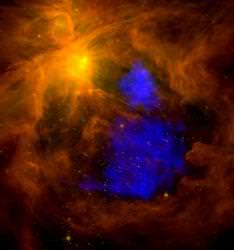Didn’t I just mention how the press agencies try to relate an image to the holidays? This time, ESA has release an image they think looks like Santa Claus. I don’t see it. Maybe the massive star forming region blazing in X-rays is his beard. Or the dusty surrounding clouds is the reindeer. Nope, I still don’t see it.
The science, though, is very cool.
The image, captured by ESA’s XMM-Newton X-ray observatory is of the Orion Nebula; one of the most famous places in space. The bright star that dominates the image is theta1 Orionis C, a giant star with 40 times the mass of the Sun.
Astronomers think that the collision between the wind from the star and the surrounding gas has heated the environment up to millions of degrees. Hot gas like this has been seen around the most vigorous star forming regions in galaxies, but never around such a small collection of stars.
In optical and infrared images of the region, the highest temperature regions of the nebula just look like a big cavity. But under the view of XMM-Newton, what looks like empty space is actually glowing in X-rays.
A team working with the observatory discovered this cloud of gas while they were doing a survey of the young stars in the region. There was a faint background glow of X-rays in many of the stars. After this was seen several times, the astronomers decided to see if it was actually in the background everywhere.
Researcher Manuel Güdel proposes that this could be an additional way for heavy elements to get into space. “This is another possible way to enrich the interstellar medium. You don’t have to wait for a sudden supernova to explode. You can do it with just one or two massive stars over millions of years.”
Oh wait, that top part is Santa’s hat, and that bottom part is his beard? I’ll keep trying to see it.
Original Source: ESA News Release

